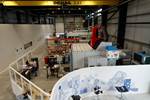Structural S-Glass laminates for V-bottomed offshore powerboats
Winning powerboat manufacturer specifies VeTron S-2 glass.
Offshore powerboat racing is not for the faint of heart. Competitors pilot streamlined craft with 500 to 1,000 hp at speeds of 100 mph or more, through ocean waves that can exceed 10 ft in height. Originally started as point-to-point races over long distances - from Miami to the Bahamas and back, for example - offshore events today are held relatively close to the beach, on 10- to 15-mile circuits, so that spectators and television crews can see and record the action.
Steve Stepp, president of Initial Marine Corp. (Sanford, Fla., U.S.A.), maker of Velocity powerboats, is a 40-year veteran of offshore racing. His boat designs have captured course records and speed records, because they are not only fast, but extremely durable - able to stay together during the incredible pounding a boat takes during a race.
"You can design a boat to be very light, with minimal hydrodynamic drag, for calm water, or you can design it heavier to last in very rough water - we try to hit the middle of the road," says Stepp. "The ideal is to make the boat as strong as possible to last for several seasons, but keep the weight down to where it's as fast as possible, and that is a big design challenge."
The "Stuff" Of Powerboat Design
Powerboats are V-bottomed monohulls, with the precise design of the hull bottom varying from manufacturer to manufacturer. When viewed in cross-section, a powerboat resembles an oblate (slightly flattened) cylinder, formed by the hull and the attached deck. In a normal pleasure boat, operated at relatively low speeds, the majority of the stresses are located far aft, because of the weight of the engine(s). The aft hull bottom and sides are where extra local reinforcement is used to resist engine and passenger weight as the boat bounces up and then impacts the waves.
In contrast, an offshore racer has to withstand the tremendous and violent force of a "stuff" - the phenomenon in which the boat flies airborne off a wave and plunges its bow into the next wave. The bow is slowed by the force of the impact, yet the rest of the boat is still moving at high speed. This rigorous and cyclic shock loading requires a laminate strong enough to resist the impact and rigid enough to prevent the boat from literally folding in half. Stuff impacts can reach 5 Gs or more, according to naval architect Michael Peters, principal of the design and engineering firm Michael Peters Yacht Design (Sarasota, Fla., U.S.A.) and designer of high-end offshore racing boats and yachts.
Related Content
-
We4Ce designs rotor blades for TouchWind’s floating one-piece rotor turbine
Tiltable, liftable one-piece composite rotor design aims to withstand storm-force winds, boost energy yield and enable more compact offshore wind farms.
-
Mel Composites infusion strategy enables Sasga Yachts fiberglass hull designs
Mel’s ongoing partnership culminates in the development of the Menorquín 42 and Menorquín 54 motor yachts, as well as extension of Sasga’s capacity for 68-foot-length boats.
-
Cannon introduces in-line resin degassing unit for infusion, RTM and pultrusion processes
Fully automatic system for processing large composite structural parts reduces overall degassing time in a single compact unit.






